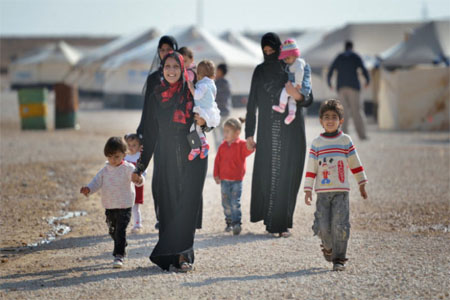
Afrasianet - by Alexander Werman - Jordan’s economy was weakly integrated with Syria’s before the war. Syria was never a major patron or aid provider to Amman in the way that the Gulf countries have been. Therefore, there were no major upheavals in Jordan right away, in fact, the initial flow of Syrian refugees led to moderate gains. They helped increase consumption when some Syrian businesses relocated to Jordan. However, the proximity of the Syrian war eventually had negative spillover impacts on its neighbor.
Syria’s impact on Jordan
Jordanian transit trade that utilizes Syrian infrastructure to send goods to farther markets such as Lebanon, Turkey, and Europe was damaged. This transit trade amounted to approximately 30% of imports and 11% of exports for Jordan, thus causing major disturbances. Syria’s Motorway System multi-lane highway that connected Jordan to Syrian port cities of Tartus and Latakia, northern cities like Aleppo, and even Lebanon was disrupted and Jordanian exporters had to find alternative trade routes.
The conflict has also put tremendous pressure on public sector services and healthcare infrastructure in Jordan because of the influx of refugees. Furthermore, Syrians are also competing on the informal labour market with Jordanians where they are able to get jobs more easily. This has led to more inter-communal tensions and increased hostility among some Jordanians, which could have negative, unforeseen impacts in the future.
Jordan’s economy today
Regional instability, including the Syrian war, beginning in 2011 has sent shockwaves through Jordan’s economy. From 2000 to 2009 annual GDP growth averaged 6.5%. Yet from 2010 to 2016, it shrunk to just 2.5% annually, and in 2017 it was only 2.0%. This downturn has led to economic policy changes that created significant political ramifications and has shaken the Hashemite regime’s standing. Jordan has gone through 7 prime ministers since 2011, a number far larger than the 2 parliamentary elections in that same timespan. The King often uses the prime minister as a scapegoat and sacks him to deflect public criticism.
Jordanians held large protests after the government cut fuel subsidies in 2012 as it tried to secure an IMF loan. It then faced another round of large protests in 2018 after it introduced an IMF-backed tax bill that abolished subsidies on pitta bread and raised the general sales tax. This has primarily hurt working-class Jordanians that rely on subsidies to make ends meet. These issues can be traced back to the Middle East’s broader economic downturn. Regional instability has hindered trade and development since 2011.
Challenges
Additionally, out of the approximately 740,000 refugees in the country, 670,000 are from Syria. They compete with Jordanian citizens for jobs in multiple fields, but especially the informal sector. The introduction of Syrian refugees almost certainly played a role in the suppression of wage growth that has occurred in the informal sector and intensified the poverty among Jordan’s most vulnerable communities. Furthermore, the war in Syria likely caused the stagnation in tourism in Jordan from 2011 to 2014 as well as the precipitous drop that happened in 2015 and continued through 2018. The country’s top five contributing sectors to GDP are government services, finance, manufacturing, transport, and tourism & hospitality, respectively. All of these have been impacted either significantly or in part by the Syrian civil war.
Over the past three decades, Jordan has been working to strengthen and reform the economy. It has undertaken free trade agreements, privatization, and targeted investment in strategic sectors. It has free trade and economic association agreements with European countries, a free trade agreement with the US since 2001, and is a member of the Greater Arab Free Trade Area. Its privatization program has unloaded many state-owned entities in the energy, transportation, and telecommunications sector. This helped to raise funds that were used to alleviate a significant portion of the Kingdom’s debt and led to a better performance by many of the companies. Efforts at increasing investment in strategic sectors have accelerated since 2011. They have focused on building the knowledge economy and dealing with the dearth of domestic energy sources.
Energy reform
Jordan has been an importer of energy and is working to change that with major investments. These are aimed at tapping its large underground oil shale reserves and developing renewable energy sources. The World Energy Council estimates that it has the fifth largest oil shale reserves. Jordan recently awarded a Saudi oil company the rights to explore some of those reserves. International companies have been pouring in to take part in wind and solar projects. General Electric is providing its latest generation wind turbines to Mass Global, which is developing a 100 MW Mass Wind project in the country. South Korea’s Korea Electric Power is building an 89.1-MW wind farm outside of Amman. These are just a few of the many renewable energy projects underway.
Therefore, it is heavily dependent on its Middle Eastern neighbours for meeting domestic energy needs. It previously relied on Egypt and the Arab Gas Pipeline for most of its energy needs. However, the ISIS insurgency in the Sinai led to continual disruptions in service that severely impinged on Jordan’s energy security. As of 2016, Jordan imported all of its crude petroleum and one-fourth of its refined petroleum from Saudi Arabia. It imported petroleum gas and the rest of refined petroleum from various countries. Jordan imports 90% of its domestic energy needs and spends 40% of its budget on those imports, if it can become more self-sufficient it can cut a major source of capital outflow and reliance on countries that hail from unstable regions.
REACH2025
Jordan is also highly focused on becoming a technology hub within the Middle East. Its REACH2025 strategy aims to digitize the economy and focus attention on a myriad of sectors such as health, education, and security, amongst others. Private and public sector entities are being incentivized to take more risks to utilize newer technologies. For example, the Arab Jordan Investment Bank recently introduced an Oracle blockchain-based platform, to make transactions more efficient between its headquarters in Amman and its Cypriot subsidiaries, and the Central Bank has implemented pilot programs using blockchain. As of early 2017, Jordan’s information and communication technologies sector hosted 600 active technology companies, of which 300 were startups.
Economic opportunities involving Syria
Although their economies were not deeply integrated, Jordan still had historical trade ties with Syria and before the conflict was its 5th biggest Arab trading partner. Jordan is home to a high number of Syrian refugees that still have family in Syria. As of 2017, there were over 41,000 Syrians with workers permits living in Jordan; 20,000 of them worked in the agricultural sector, 4,700 in manufacturing, and 250 in the transportation sector. The people in these economic sectors can play a role in Syria’s post-conflict economy by returning home and opening businesses or using connections to the people that never left to develop business relationships from inside Jordan.
AFP reported that roughly 28,000 Syrian refugees living in Jordan had returned home in the month following the opening of the Nassib Border crossing in October 2018. With 5 million refugees, there will likely be a steady flow of returning refugees as the situation becomes calmer. Jordan can leverage all of this to establish export businesses and supply chains with Syrian counterparts, all within the bounds of what American sanctions allow.
In conclusion
Syria’s economy and its people will continue to face a bevvy of issues as this war starts to wind down. Technology solutions driven by Jordanian expertise can help to provide new, efficient solutions to everyday problems that they face. Information communication technologies can spread information on new methods for water-efficient agriculture techniques like aquaponics in damaged farmland. Syrian oil rights are highly disputed meaning, not all parties will be able to access them. Therefore, the powers that be should invest in long-term energy solutions that reduce dependency on outside sources.
Since Assad’s patrons are major oil and gas producers his regime will likely continue to rely on them for energy. However, at a grassroots level, Syrian governorates and provinces may conclude that diversifying their energy sources and using renewable energy will be beneficial in the long-term. Jordanians can play a role in developing plans and implementing projects for alternative energy infrastructure. Syria can help drive growth in Jordan’s burgeoning knowledge-economy by becoming a market for it.
Recently, Jordan and Syria re-opened the Nassib border crossing after a three-year hiatus. This important development means that Syrian importers can receive goods from Jordan by land in just three days as opposed to the maritime route through the port of Aqaba that by some estimates took a whole month. This is the beginning stage in what could be a significantly rejuvenated trade relationship.
The transformation of this conflict and calming of hostilities will offer an opportunity that Jordan may be able to take advantage of economically. Part three of the series will consider the economic impact of the Syrian war on Iraq, and its future implications.
January 18, 2019

